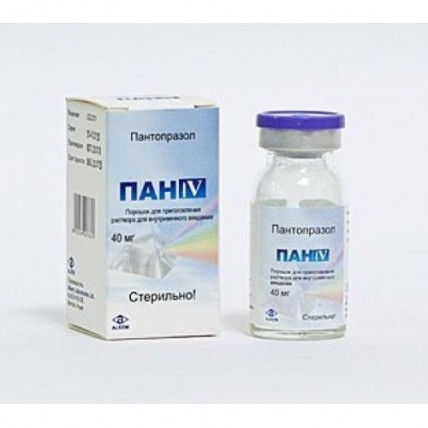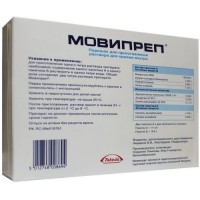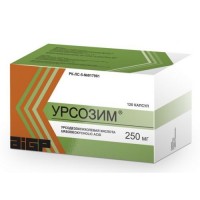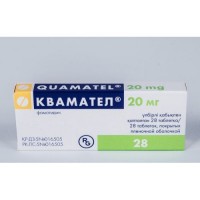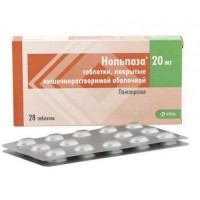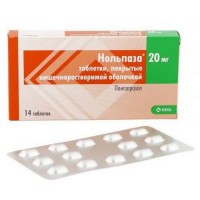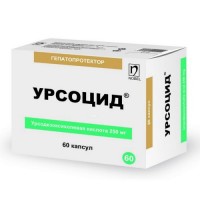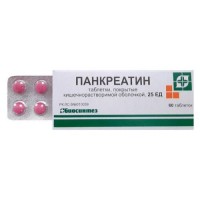Pan IV 40 mg powder for solution / in
- $13.10
The instruction for medical use of SIR medicine IV the Trade name the SIR the IV International unlicensed name Pantoprazol Lekarstvennaya a form Powder for preparation of solution for intravenous administration, 40 mg Structure One bottle contains active agent – pantoprazol (in the form of sterile mix of a pantoprazol of sodium with Mannitolum) 40 mg, excipient - Mannitolum. The description Loose powder from white till almost whitish color. Pharmacotherapeutic group Drugs for treatment of the diseases connected with disturbance of acidity. Antiulcerous drugs and drugs for treatment of a gastroezofagalny reflux. Inhibitors of the protonew pump. Pantoprazol. ATX A02BC02 code Pharmacological Pharmacokinetics Absorption properties: at intravenous administration of 40 mg of a pantoprazol the maximum concentration in blood plasma is reached in 1 h after infusion and makes 5.53 mg/l. The volume of distribution is about 0.15 l/kg, clearance – about 0.1 l/kg. Linking of a pantoprazol with proteins of blood plasma makes about 98%. Removal and metabolism: pantoprazol it is almost completely metabolized in intestines. The main metabolite is the dezmetilpantoprazola sulfate. About 80% of drug are removed by kidneys, other quantity is distinguished with excrements. Elimination half-life of the main metabolite makes about 1.5 h, a pantoprazol – about 1 h. Pharmacodynamics H+-K+-ATF-azy Inhibitor. Reduces level basal and stimulated (irrespective of a type of an irritant) secretions of hydrochloric acid in a stomach. In a peptic ulcer of the duodenum associated with Helicobacter pylori, such decrease in gastric secretion increases sensitivity of a microorganism to antibiotics. Pantoprazol has own antimicrobial activity concerning Helicobacter pylori. Indications a peptic ulcer of a stomach or duodenum Zollingera-Ellison's syndrome and other states which are characterized pathological hypersecretion a reflux esophagitis. The route of administration and doses Intravenous use of a pantoprazol is recommended only at impossibility of administration of drug inside. As soon as oral therapy becomes possible, intravenous therapy has to be stopped. There are data on intravenous administration of drug within 7 days. Peptic ulcer of a stomach or duodenum, reflux esophagitis. Recommended in/in a dose makes 40 mg a day. Zollingera-Ellison's syndrome and other states which are characterized by pathological hypersecretion. For the long-term treatment of a syndrome of Zollingera-Ellison and other states which are characterized by pathological hypersecretion patients have to begin treatment with a dose of 80 mg Pang IV in / century. After that the dose can be increased or reduced. In case of use of drug in a daily dose over 80 mg, a dose can be divided and be entered twice a day. Perhaps temporary increase in a daily dose up to 160 mg. Special groups of patients Patients with an abnormal liver function: it is not necessary to exceed a daily dose of 20 mg of a pantoprazol at patients with heavy abnormal liver functions. Patients with a renal failure: for patients with a renal failure it is not necessary to exceed a daily dose of 40 mg. Elderly people: for elderly people it is not necessary to exceed a daily dose of 40 mg. Duration of a course of therapy is established depending on indications. Rules of preparation and administration of the drug Solution for intravenous administration: with dry, sterile powder add 10 ml of 0.9% of solution of sodium of chloride for injections to a bottle. This solution can be applied directly (intravenously struyno) or after mixing from 100 ml of 0.9% of solution of sodium of chloride and also from 5% by glucose solution (intravenously by drop infusion). Introduction duration: 2–15 min. Side effects are listed below the observed side reactions with a frequency of their occurrence: very often ( 1/10), it is frequent (from 1/00 to 1/10), infrequently (from 1/1000 to 1/100), is rare (from 1/10000 to 1/1000), very seldom ( 1/10000), it is unknown (it is impossible to estimate on the available data). Often – thrombophlebitis in the injection site of an injection Infrequently a headache, dizziness dryness in a mouth, nausea, vomiting, an abdominal distension, abdominal pain and discomfort, diarrhea, a constipation skin rash, an itching, a dieback an asthenia, fatigue and an indisposition increase in activity of liver enzymes (transaminases, -GT) a sleep disorder Seldom an agranulocytosis hypersensitivity to active and to auxiliary components of drug (including anaphylactic reactions and an acute anaphylaxis) a lipidemia, increase in level of triglycerides, cholesterol increase in content of bilirubin change of weight, disturbance of taste a depression (and all accompanying deteriorations) disorder of vision / illegibility of sight urticaria, a Quincke's disease an arthralgia, myalgia a gynecomastia Very seldom thrombocytopenia, a leukopenia, a pancytopenia a disorientation (and all accompanying deteriorations) Does not know fervescence, peripheral hypostases a hyponatremia, a hallucination hypomagnesiemia, confusion of consciousness (especially at the patients predisposed to these states and also deterioration in these symptoms if they existed prior to treatment) hepatocellular damages, jaundice, hepatocellular insufficiency Stephens-Johnson's syndrome, a Lyell's disease, an exudative mnogoformny erythema, photosensitivity interstitial nephrite of the Contraindication the profound renal failures children's and teenage age up to 18 years hypersensitivity to drug components, another substituted benzimidazole combined use of a pantoprazol with atazanaviry Medicinal interactions It is necessary to pay attention to a concomitant use with drugs which absorption is rn-dependent, for example ketokonazol, itrakonazol, pozakonazol, erlotinib, including with the drugs appointed shortly before a course of treatment Pang IV in view of change of absorption of these drugs. The concomitant use of a pantoprazol and an atazanavir considerably reduces efficiency of the last. Co-administration of inhibitors of a proton pomp with atazanaviry is not recommended. At combined use of a fenprokumon or warfarin, several isolated cases of change of the International normalizing relation were celebrated (MNO or INR). Therefore for the patients undergoing treatment by coumarinic anticoagulants (for example, fenprokumony or warfarin), it is recommended to watch a prothrombin time / MNO after the beginning, the termination or during irregular use Pang IV. Pantoprazol has the low potential of interaction with the system of P450 cytochrome. Therefore the risk of the side reactions caused by Ban's interaction by IV with other drugs which is metabolized a system P450 cytochrome can be considered as minimum. Special researches did not reveal clinically significant interaction of a pantoprazol with caffeine, carbamazepine, diazepam, ethanol, diclofenac, glibenclamide, Naproxenum, metoprololy, nifedipine, Phenytoinum, piroxicam, theophylline, the oral contraceptives containing levonorgestrel and ethinylestradiol. At a concomitant use with antibiotics, such as klaritromitsin, amoxicillin, with metronidazole, interactions it is not revealed. At patients with heavy abnormal liver functions at Ban's introduction by IV, especially during the long period, regular control of level of enzymes of a liver is recommended to carry out special instructions. At increase in level of liver enzymes it is necessary to stop drug use. At combination therapy it is necessary to consider in general all characteristics of the used drugs. At treatment Pang IV can decrease expressiveness of symptoms of malignant diseases that can delay establishment of the correct diagnosis, in communication with what before an initiation of treatment it is necessary to exclude a possibility of a malignant new growth. Patients have to consult with the doctor in the following cases: - if symptoms did not pass within 2 weeks - involuntary weight reduction of a body, anemia, gastrointestinal bleeding, a dysphagy, persistent vomiting or vomiting with blood, in these cases, it is necessary to exclude existence of malignant process - earlier there was stomach ulcer, or the undergone surgery on a stomach - disturbances of digestion or heartburn within 4 or more weeks - jaundice, dysfunctions or diseases of a liver - any other serious disease influencing overall health - patients is more senior than 55 years in the presence of the new or recently changed symptoms. Patients at whom long-term recurrent symptoms of disturbance of digestion or heartburn are observed have to see a doctor. At patients with Zollingera-Ellison's syndrome and other morbid hyper secretory conditions which treatment Pang IV demands long reception as the drug blocking secretion of acid in a stomach reduction of absorption of B12 vitamin (cyanocobalamine) owing to hypo - or achlorhydrias is possible. It should be considered in the presence of the corresponding clinical symptoms. Lowering of acidity of a stomach increases quantity of gastric bacteria which usually are present at digestive tract. Treatment by the drugs lowering acidity leads to increase in risk of developing the gastrointestinal infections caused by such microorganisms as Salmonella, Campylobacter. Use in pediatrics of Data on use of drug of Ban of IV, powder for preparation of solution for injections, up to 18 years is not available for children and teenagers. Pregnancy and the period of a lactation of Adequate data on use of a pantoprazol at pregnancy are not present. Researches on animals demonstrate reproductive toxicity of drug. The potential risk for the person is unknown. The sir should not be applied by IV during pregnancy if in it there is no obvious need. The lactation for drug treatment is stopped. Features of influence of medicine on ability to run the vehicle or potentially dangerous mechanisms. It is necessary to refrain from control of the vehicles and other mechanisms requiring special attention because of the probability of dizzinesses and a disorder of vision. Overdose Symptoms: strengthening of expressiveness of by-effects. Treatment: drug it is necessary to repeal or lower its dose. Specific treatment does not exist, carry out symptomatic therapy. A form of release and packing On 40 mg of active agent in the bottles of colourless glass with a capacity of 10 ml corked by rubber bungs, which are pressed out by aluminum caps and closed by the protecting plastic cap (flip-off). On 1 bottle together with the instruction for medical use in the state and Russian languages place in a cardboard box. To Store storage conditions in the dry, protected from light place, at a temperature not above 25 °C. To store drug out of children's reach! 2 years not to use a period of storage after an expiration date. Prescription status According to the prescription Alkem Laboratories Ltd Producer Alkem House "Devashish", Senapati Bapat Marg, Lower Parel, Mumbai – 400,013 Owner of the registration certificate of Alkem Laboratories Limited, India of Alkem House "Devashish", Senapati Bapat Marg, Lower Parel, Mumbai – 400013, the Address of the organization accepting in the territory of the Republic of Kazakhstan claims from consumers on quality of products (goods) Representative office of Alkem Laboratories Limited Almaty, Mametov St., 67
to Develop India
to Develop India
